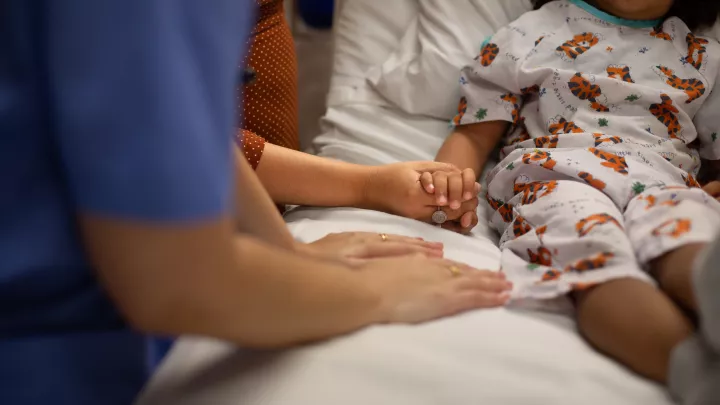
Children’s Oncology Group Collaborators Publish Latest Findings on Post-Relapse Survival for Acute Lymphoblastic Leukemia
Acute lymphoblastic leukemia is the most common childhood cancer, attacking the blood, bone marrow and immune system. Treatment advances over the last several decades have increased the 5-year survival rate for children in developed countries with newly diagnosed ALL to 85–90%.
Still, massive opportunity remains to improve outcomes for patients who relapse, as survival rates have remained largely stagnant over the past 30 years.
A cohort of researchers in the Children’s Oncology Group, including the director of the Children’s Hospital Los Angeles Leukemia and Lymphoma Program, Deepa Bhojwani, MD, recently published a study in Leukemia (a Nature journal) outlining new findings on determinants of survival after first relapse of ALL.
Improved relapse rates, clues for new prognostic indicators
The Children’s Oncology Group (COG) is a collaborative of more than 10,000 experts around the world working to uncover front-line treatments, identify the underlying biology of cancer, and conduct trials advancing new therapies, supportive care and survivorship. This COG study included health data from 16,115 infant, pediatric, adolescent and young adult patients with both immunophenotypes of ALL (B-type and T-type) who enrolled in 12 different frontline clinical trials between June 1996 and July 2014—the largest study cohort to date.
Researchers first compared this patient cohort’s outcomes to a 2008 COG study analyzing an earlier cohort of non-overlapping clinical trials from 1988 to 2002. Their findings:
- The median time-to-relapse for the 1996-2014 cohort was 31 months.
- Compared to the earlier cohort, fewer patients relapsed; relapse rates decreased from 20.5% to 12.7%.
- Patients with relapsed B-ALL had the most significant improvement in 5-year overall survival rates post-relapse, about 52% compared to about 37% in the earlier cohort.
- Patients with T-ALL had improved overall survival rates of about 35% post-relapse compared to 23% previously.
- Post-relapse survival rates for infants remained stagnant at about 20%.
One core aim of the study was to establish stronger prognostic indicators for relapse. In the paper, researchers explained that during initial therapy, doctors are equipped with several well-established prognostic factors to inform risk-directed therapy such as age, presenting white blood cell count, central nervous system involvement, cytogenetic and molecular subtype, and measurable residual disease (MRD) at the time of remission induction therapy. Post-relapse prognostic indicators are currently limited, however.
Researchers’ assessments of cohort data by immunophenotype, time and site of relapse helped surface several distinctions:
- Half of B-ALL relapses occur more than 36 months post-diagnosis and over 70% involve the bone marrow.
- 82% of T-ALL relapses occur within 36 months and central nervous system disease is involved in almost half of cases.
- 67.9% of patients with central nervous system relapse of T-ALL had the highest level of central nervous system disease at initial diagnosis, despite receiving therapeutic cranial irradiation.
- Although central nervous system relapses occur earlier than bone marrow or combined relapses in both B and T-ALL, these patients had significantly better overall survival rates post-relapse.
Researchers also identified additional clinical, cytogenetic and biological risk factors, including the patient’s threshold of MRD after remission induction treatment. The researchers suggested that future studies using next-generation testing modalities like single-cell sequencing will further illuminate the unique dynamics of each patient’s relapse trajectory.
“Infant ALL remains one of the greatest challenges”
The most significant opportunity to advance ALL treatment is in infants, where studies have been unable to demonstrate any improvement in survival post-relapse.
Infants under 18 months old who relapse have only about a 9% survival rate and no infant who relapsed while under 1 year of age survived. Intensifying therapy for infants is challenging due to toxicity, and targeted therapies incorporated in frontline treatment have not shown benefit. Early data combining the drug blinatumomab with chemotherapy is promising for newly diagnosed infants.
However, Dr. Bhojwani highlights that a novel class of targeted therapy—menin inhibitors—are currently being tested in infants with relapsed ALL and are demonstrating encouraging results.
Continued studies to improve treatment and overall survival
Given that this study cohort was enrolled in trials through 2014, several key investigational immunotherapies and targeted therapies have since emerged in the ALL treatment space. While the use of tyrosine kinase inhibitors (TKI) for certain types of ALL became more common during the study period, researchers couldn’t identify whether TKI use improved survival rates.
Future research will explore whether newer interventions for relapsed ALL, including CAR T-cell immunotherapy, will improve long-term survival. The study emphasizes that more research is needed to investigate alternatives to chemotherapy for patients with “truly dismal outcomes” post-relapse. One current COG study, AALL1821 (NCT04546399), is examining the efficacy of combining the drugs blinatumomab and nivolumab with chemotherapy.

“The results of our research will serve as a valuable benchmark to compare the impact of immunotherapy and small molecule-targeted therapy in improving survival post-relapse,” says Dr. Bhojwani, co-first author on the study. “Our analysis of this broad and diverse population across more than 200 COG treatment centers offers critical representation of all children with ALL.”
Researchers urge the pediatric oncology community to prioritize international collaborations, combined pediatric and adult trials for the adolescent and young adult population, and strategic partnerships with industry to design trials of combined targeted therapies to help overcome some of the challenges associated with pediatric oncology clinical trials.
“We hope that these data from the largest patient cohort to date will inform future trial design and highlight populations for testing more novel therapy options,” adds Dr. Bhojwani.


